

Woork Up - Web Design, Social Media, Tech News and Digital Inspiration. Pesto, Italian Sauces, Anitpasti & Italian Recipes - Sacla UK. Europe Holiday Destinations. Europe Travel - European Vacation Travel Guide. Italy Travel - Italy Vacations and Travel Guide. LSD s.r.l. - photographers. Home - Keats Shelley House. Italian cuisine. Italian cuisine has developed through centuries of social and political changes, with roots as far back as the 4th century BCE.
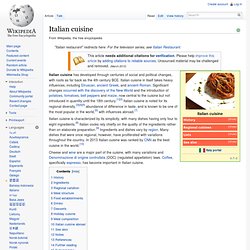
Italian cuisine in itself takes heavy influences, including Etruscan, ancient Greek, and ancient Roman. Significant changes occurred with the discovery of the New World and the introduction of potatoes, tomatoes, bell peppers and maize, now central to the cuisine but not introduced in quantity until the 18th century.[1][2] Italian cuisine is noted for its regional diversity,[3][4][5] abundance of difference in taste, and is known to be one of the most popular in the world,[6] with influences abroad.[7] Italian cuisine is characterized by its simplicity, with many dishes having only four to eight ingredients.[8] Italian cooks rely chiefly on the quality of the ingredients rather than on elaborate preparation.[9] Ingredients and dishes vary by region.
Many dishes that were once regional, however, have proliferated with variations throughout the country. Colosseum. The Colosseum or Coliseum, also known as the Flavian Amphitheatre (Latin: Amphitheatrum Flavium; Italian: Anfiteatro Flavio or Colosseo) is an elliptical amphitheatre in the centre of the city of Rome, Italy.
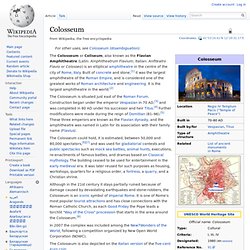
Built of concrete and stone,[1] it was the largest amphitheatre of the Roman Empire, and is considered one of the greatest works of Roman architecture and engineering. Capitoline Museums. The Capitoline Museums (Italian: Musei Capitolini) are a group of art and archeological museums in Piazza del Campidoglio, on top of the Capitoline Hill in Rome, Italy.
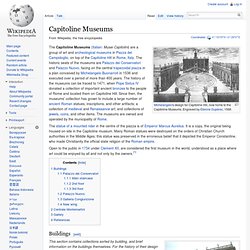
The historic seats of the museums are Palazzo dei Conservatori and Palazzo Nuovo, facing on the central trapezoidal piazza in a plan conceived by Michelangelo Buonarroti in 1536 and executed over a period of more than 400 years. The history of the museums can be traced to 1471, when Pope Sixtus IV donated a collection of important ancient bronzes to the people of Rome and located them on Capitoline Hill.
Caravaggio. Michelangelo Merisi (or Amerighi) da Caravaggio (Italian pronunciation: [karaˈvaddʒo]; 29 September 1571?
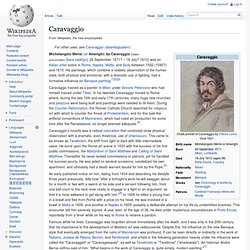
– 18 July? 1610) was an Italian artist active in Rome, Naples, Malta, and Sicily between 1592 (1595?) And 1610. His paintings, which combine a realistic observation of the human state, both physical and emotional, with a dramatic use of lighting, had a formative influence on Baroque painting.[1][2][3] Caravaggio trained as a painter in Milan under Simone Peterzano who had himself trained under Titian. An early published notice on him, dating from 1604 and describing his lifestyle three years previously, tells how "after a fortnight's work he will swagger about for a month or two with a sword at his side and a servant following him, from one ball-court to the next, ever ready to engage in a fight or an argument, so that it is most awkward to get along with him Biography[edit] Early life (1571–1592)[edit] Rome (1592/95–1600)[edit] Caravaggio left Cesari, determined to make his own way.
Dante Alighieri. Durante degli Alighieri (Italian: [duˈrante ˈdeʎʎi aliˈɡjɛːri]), simply called Dante (Italian: [ˈdante], UK /ˈdænti/, US /ˈdɑːnteɪ/; c. 1265–1321), was a major Italian poet of the late Middle Ages.
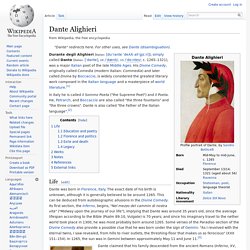
His Divine Comedy, originally called Comedìa (modern Italian: Commedia) and later called Divina by Boccaccio, is widely considered the greatest literary work composed in the Italian language and a masterpiece of world literature.[1] In Italy he is called il Sommo Poeta ("the Supreme Poet") and il Poeta. He, Petrarch, and Boccaccio are also called "the three fountains" and "the three crowns". Dante is also called "the Father of the Italian language".[2] Life[edit] Portrait of Dante, from a fresco in the Palazzo dei Giudici, Florence Dante claimed that his family descended from the ancient Romans (Inferno, XV, 76), but the earliest relative he could mention by name was Cacciaguida degli Elisei (Paradiso, XV, 135), born no earlier than about 1100. Bell' alimento. Italy Travel Guide to Hotels, Vacations, Tours.
My Bella Vita: Life and Travel in Calabria. When In Rome Tours - Vatican Tours, Vatican Museum Tours, Vatican City ... The Digital Michelangelo Project.